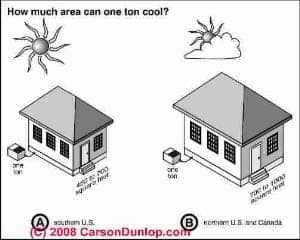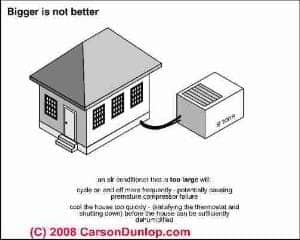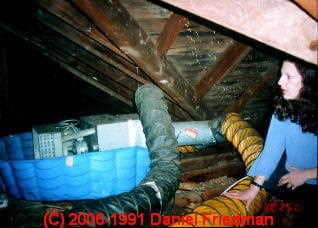 How to determine the cooling capacity of air conditioning or heat pump equipment
How to determine the cooling capacity of air conditioning or heat pump equipment
- POST a QUESTION or COMMENT about how to find out the cooling capability of an air conditioner or heat pump from translating its data tag, label, or other information.
Rated cooling capacity of an air conditioner or heat pump:
Here we explain exactly how to estimate the rated cooling capacity of an air conditioning system by examining various data tags and components.
InspectAPedia tolerates no conflicts of interest. We have no relationship with advertisers, products, or services discussed at this website.
- Daniel Friedman, Publisher/Editor/Author - See WHO ARE WE?
RATED COOLING CAPACITY - How to Determine Air Conditioning or Heat Pump Equipment Rated Cooling Capacity
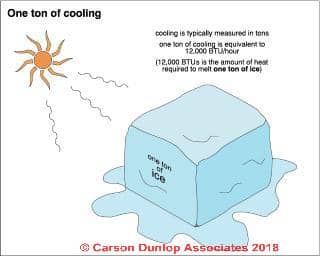 The cooling capacity of an air conditioning system is expressed in BTU's or tons. One ton of cooling
capacity equals 12,000 BTU's/hour of cooling capacity.
The cooling capacity of an air conditioning system is expressed in BTU's or tons. One ton of cooling
capacity equals 12,000 BTU's/hour of cooling capacity.
[Click to enlarge any image]
"One ton" of cooling capacity, historically, referred to the cooling capacity of a ton of ice. Tons of ice does not explain a key ingredient in the comfort produced by air conditioning systems, dehumidification of indoor air - that is, taking water out of the air.
Cool air can hold less water (in the form of water molecules or gaseous form of H2O) than warm air. Think of the warmer air as having more space between the gas molecules for the water molecules to remain suspended.
When we cool the air, we in effect are squeezing the water molecules out of the air.
When an air conditioner blows warm humid building air across an evaporator coil in the air handler unit, it is not only cooling the air, it's squeezing out some of the water in that air. Both of these effects, cooler air and drier air, increase the comfort for building occupants. Sketch courtesy of Carson Dunlop Associates, a Toronto home inspection, education & report writing tool company [ carsondunlop.com ].
There are several ways to determine the rated cooling capacity of an air conditioning system's equipment:
Air Conditioning Equipment Age and Capacity from Equipment Numbers
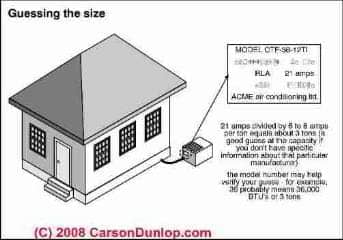 Serial number formats vary by range of years over which equipment was manufactured, and may
vary among countries of manufacture for a given company's equipment, for example between the
U.S. and Canada for Carrier air conditioning equipment.
Serial number formats vary by range of years over which equipment was manufactured, and may
vary among countries of manufacture for a given company's equipment, for example between the
U.S. and Canada for Carrier air conditioning equipment.
Example: a Carrier Compressor/Condenser Serial# 1389E54894 on a compressor unit.
Air conditioning equipment age from serial number for the example above, the equipment was made after 1980. The first four digits of the serial number are week and year of manufacture, in this case, week 13 of 1989.
See AIR CONDITIONER BTU CHART for a guide to selecting an air conditioning system with the proper cooling capacity in tons or in BTUs.
Sketch courtesy of Carson Dunlop Associates, a Toronto home inspection, education & report writing tool company [ carsondunlop.com ].
FROM MODEL # - Air conditioning equipment capacity from model number
Example: Carrier A/C Compressor Condenser Model# 38XD12400 (same unit as used for the serial number example above), there is variation in how Carrier assigned these numbers but typically the numbers indicate either tonnage or MBTUH. This example has digits in the 4th and 5th positions (right hand 5 digits), so the rating is in MBTUH for this number and "24" signifies 24 MBTUH or 2 tons of capacity.
Be sure to review our article on how to read the data in
A/C DATA TAGS for a guide to reading the system cooling capacity either directly off of the sticker on the equipment, or for examples of
how to find them model number which can be de-coded into cooling capacity and other features.
A Reference Guide to Heating and Air Conditioning Equipment model numbers, serial numbers, age, and capacity: at Carson Dunlop's - Technical Reference Guide, published by Carson Dunlop Weldon & Associates, Ltd., Toronto, 2006 for a $69.00 book which translates air conditioning equipment model numbers and serial numbers into date of equipment manufacture and rated BTUH capacity.
FROM EQUIPMENT RLA # - Air Conditioning Equipment Capacity from Equipment RLA Numbers
RLA Rule of Thumb: RLA, Rated Load Amps, or in some older texts, mis-named as "Running Load Amps" is the manufacturer's specified rated current draw when the equipment is operating, excluding the current draw during startup, but when the compressor is under load.
On a single-phase 240V circuit feeding an A/C compressor/condenser unit, the equipment will draw typically 5 to 6, (7 in some cases) RLA per ton of cooling capacity.
So if the data tag on a compressor shows its RLA rating=21.2 I would rate the system as 21.2/7=3 Tons.
Translating Tons into BTUH, 3tons x 12 MBTUH/ton = 36,000 BTUH estimated Cooling Capacity. Details of this and related calculations are in the "Guide" book cited above.
COOLING RULES OF THUMB - determining Cooling Capacity Requirements - Rules of Thumb
A home inspection does not involve the calculations of heat gain necessary to decide if the cooling capacity on a building is adequate, but the inspector is expected to examine and report on the rated system capacity (such as "36,000 BTUH") and on the presence or absence of cooling sources in the habitable rooms of the building.
Air conditioning capacity requirement:
A simple rule of thumb for relatively cool climates such as the Northeastern United States: one ton per 400 sq .ft. (Commercial) or one ton per 500 to 1000 sq .ft. (Residential)
Or we estimate an air conditioning requirement of one ton per 400 to 800 sq .ft. for Space Pak Systems.
Or a 3000 sq .ft. house may require a 5-ton unit. Or count the supply outlets: 10 outlets @ 100 cfm (estimated) = 1,000 cfm = 2.5 tons needed.
Oversized Air Conditioning Systems: Can an air conditioning system have too much capacity?
Yes. If a system is over sized for a building it may be able to drop the indoor temperature so rapidly that the cooling cycle is too short to permit adequate reduction in the humidity level. Remember that indoor comfort is a function of both temperature and relative humidity.
Also, since an oversized air conditioning system will be cycling on and off more frequently, not only is the building actually less comfortable (temperatures are swinging up and down unnecessarily quickly and frequently) but it may also be harder on the equipment, thus shortening its life.
Turning electric motors on and off is hard on them.
If the "on cycle" of the A/C system seems unusually brief, or if the indoor humidity is not dropping this question merits further investigation. Sketch courtesy of Carson Dunlop Associates, a Toronto home inspection, education & report writing tool company [ carsondunlop.com ].
Do not buy an air conditioner that has more tons or BTUs of capacity than you actually need.
How to Determine BTUs or Tons of Cooling Capacity of an Air Conditioner from its Data Tags
In addtion to reading the present article (here) see
COOLING COIL or EVAPORATOR COIL
or determine rated cooling capacity
FROM MODEL # - how to determine the BTU capacity or Tons of cooling capacity of an air conditioner from model number
FROM EQUIPMENT RLA # - how to determine the BTU capacity or Tons of cooling capacity of an air conditioner from the RLA number.
How Big Should My Air Conditioner Be in BTUs or Tons?
In addition to reviewing
our COOLING RULES OF THUMB shown above,
see AIR CONDITIONER BTU CHART for a guide to selecting an air conditioning system with the proper cooling capacity in tons or in BTUs.
What Temperature Should an Air Conditioner Be Able to Maintain
Reader Question: 8/27/2014 Anonymous said: hat temperature should my new central A/C be able to hold
Regardless of all the sizing, energy usage and environmental considerations, what temperature should my new central A/C be able to hold at the hottest time of day? It seems like this should by irrespective of any particular climate, just need more capacity the hotter it can become.
Reply:
I'm not sure I agree that the performance of air conditioning systems - the ability to hold a specific temperature at the hottest time of the day - is nor can be independent of the system design.
For example, if we have a poorly insulated building, a building with high heat gains, a building where people regularly leave windows and doors open or come in and out constantly, it could be misleading and specious to only blame the air conditioning system for complaints that the building interior is too arm.
Wouldn't we first close open windows and doors, before installing a new, larger cooling system?
However you are quite right to ask how we should measure whether an AC system is performing as it should.
Some helpful references that answer that question are at
ANSI/AHRI Standard 210/240 with Addenda 1 and 2 (formerly ARI Standard 210/240) titled in more detail "2008 Standard for Performance Rating of Unitary Air - Conditioning & Air-Source Heat Pump Equipmet" (available online from AHRI and ANSI)
You might also want to refer to TSI's "Hvac Assessment Handbook A practical guide to performance Measurements in mechanical heating, Ventilating, and air conditioning systems" available from tsi [dot] com
In Australia and New Zealand or the South Pacific we refer readers to "Performance Standards Of Hvac Equipment (HVAC Equipment Performance Consultancy)" available from the Australian government abcb [dot] gov [dot] au
...
Reader Comments, Questions & Answers About The Article Above
Below you will find questions and answers previously posted on this page at its page bottom reader comment box.
Reader Q&A - also see RECOMMENDED ARTICLES & FAQs
On 2020-07-20 - by (mod) -
I don't have specifications for that air conditioner and don't recognize the brand. If you can see a brand name and search for the manual for the brand and model air conditioner you'll see the BTU rating. But before going to that trouble take a look on the data tag its software usually the BTU rating is given right on the tag.
Try posting a photograph of the data tag using the add image button
On 2020-07-20 by Nerma
i want to find out ehat is the capacity of my mom ac
Model:Yacm062mmo
Serial:omp0905632
Type:0036
On 2020-03-04 by Anonymous
Peter
Sounds reasonable to me. Keep in mind that you can also improve the energy efficiency of the home to lighten the cooling load: low-e windows, insulation, fixing air leaks, sunshades, etc.
On 2020-03-04 by Peter
Hi:
Thanks for your advice. We are going to go with the 2.5 ton system to aim for better de-humidification. Although Tech said we may only be able to get in the upper 70's or 80 on days 95 degrees and above with the 2.5 ton system (15-20 degree difference at best), those days are not as common as the upper 80's and humid, when we really need the system to work effectively/ efficiently. Hopefully we are not making a big mistake, but dealing with an over-sized system has been a bit of a pain, so we want to avoid that. Also, I have read that Manual-J calculations tend to overestimate the size of the AC system needed. If we had a full year before all this fell on us, we would have better info for making a decision, but we got unlucky.
On 2020-02-27 - by (mod) -
Yes
Smaller - less cooling capacity - lower tonnage but I can't guess between going from 3.5T down to 3.t or to 2.5T. If the techs think 2.5T will be adequate that's best.
Oversizing AC units is such a notorious problem that it's illegal in some jurisdictions.
On 2020-02-27 by Anonymous
Hi:
Thanks for responding. By smaller unit, you mean the 2.5 ton correct? Sorry if this is a stupid question, I am asking just because you mentioned my 3.5 ton system and the 3 ton unit is also "smaller," than what we already have.
On 2020-02-27 - by (mod) -
Peter
The risk of over-sizing is that the system cools too fast and doesn't dehumidify.
If your original cooling capacity was 3.5 tons then staying close to and certainly not over that sounds safe to me.
The fact that you've improved the home's energy efficiency by air-sealing, duct replacement, balancing air flow, adding insulation all mean that your heating and cooling loads ought to be reduced.
The short-cycling you were finding suggests to me that - as I infer you agree - the old 3.5T unit was oversized for the home.
My inclination is usually to go with the smaller unit - it may need to run longer until you've done your further energy improvements.
Sorry for a bit of weaving and ducking, but truth is I'm not smart enough to guess at what the right size is for the new system - I don't know how to map from theory to reality: just how a home is laid out, its actual air leakiness, insulation, points of heat gain or heat loss, windows, orientation, etc. make me inclined to trust the local HVAC guys.
On 2020-02-26 by Peter
Hi. Peter here again.
I need some more advice...and quick. I need to decide if I should get a new AC system that is 2.5 tons and is total 0.94 cooling capacity (according to Manual J and Manual S), or a 3 ton system that is 1.12 cooling capacity. The HVAC company says the range is 0.95-1.15. My total latent load is 3,641 and total sens load is 27,051.
My existing ac system is a 3.5 ton XR 15 Trane with the air handler and ducts in attic. The unit is about 10 years old, and I live in southern NY, at the bottom of climate zone 5.
My house is 2200 square feet and 2 stories. We re-did the ducts, and added a new duct downstairs. The system is balanced better and the downstairs finally gets cool, but the system still short cycles (typically 6-10 min cycles), which it did before we got the new ducts. We then had air-sealing and attic insulation added to our attic as a separate project for home efficiency.
After this work we discovered that the air handler has a cracked condensate line that caused leaking into the unit, and emergency pan, causing mold and wet insulation. We can repair the parts for $1,900 -$2,500 depending on how much we want to repair (the insulation inside the unit is moldy/ in bad condition), or replace just the air handler and adjust the fan speed and hope that helps with the short cycling. (for about $4000), or replace the whole system (for about $8,000).
The HVAC guy did a manual J and a manual S with some of the basic values above. I am worried that the 2.5 ton unit might not cool effectively (especially considering future rising temps from climate change), but that the 3 ton unit will short cycle, or just not de-humidify effectively and we will be left with the same problem we started with: a system that short cycles, leading to a humid, clammy house. We do have some long term plans for renovations that could increase efficiency in the future (basic remodeling/re-insulating downstairs, replacing windows, etc.), which possibly would make a smaller unit more effictive or a larger unit too big relatively.
We have not had a full summer with the existing system, new ducts and air sealing/insulation work, so we don't really have enough information, BUT the clock is ticking for discounted install/ repair, so we don't have time to wait a year and see.
Whereas I have given you a lot of complicated information, I guess the issue boils down to: (1) get a 2.5 ton (slightly undersized) air conditioner and hope it meets future cooling needs, (2) get a 3 ton (almost oversized) air conditioner and hope that it dehumidifes and future renovations don't make it relatively oversized, (3) just get a new air handler and adjust the fan speed and hope that solves the problem for a while until the system breaks in a few years, (4) Do a minimal repair on the system, ignore the mold (some of which I killed/ cleaned out), and hope that a fan speed adjustment will help.
Thanks for all of your help. (I have attached one of the Manual S calculations (the one for the smaller system), I think the latent and sensible loads are accidentally reversed on this, but most of the ratios come out the same when they are switched. When corrected the b+f = 24,135 or 89.22% of total sensible load capacity.
-Peter
-PH
...
Continue reading at SEER RATINGS & OTHER DEFINITIONS or select a topic from the closely-related articles below, or see the complete ARTICLE INDEX.
Or see RATED COOLING CAPACITY FAQs - questions & answers posted originally at this page.
Or see these
Recommended Articles
- AIR CONDITIONER TEMPERATURE MEASUREMENT what temperatures to expect at different points in the air conditioning system.
- AIR CONDITIONER BTU CHART - table of BTU requirements by cooling area size & other parameters
- LOST COOLING CAPACITY diagnosis of poor air conditioner performance
Suggested citation for this web page
RATED COOLING CAPACITY at InspectApedia.com - online encyclopedia of building & environmental inspection, testing, diagnosis, repair, & problem prevention advice.
Or see this
INDEX to RELATED ARTICLES: ARTICLE INDEX to AIR CONDITIONING & HEAT PUMPS
Or use the SEARCH BOX found below to Ask a Question or Search InspectApedia
Ask a Question or Search InspectApedia
Try the search box just below, or if you prefer, post a question or comment in the Comments box below and we will respond promptly.
Search the InspectApedia website
Note: appearance of your Comment below may be delayed: if your comment contains an image, photograph, web link, or text that looks to the software as if it might be a web link, your posting will appear after it has been approved by a moderator. Apologies for the delay.
Only one image can be added per comment but you can post as many comments, and therefore images, as you like.
You will not receive a notification when a response to your question has been posted.
Please bookmark this page to make it easy for you to check back for our response.
IF above you see "Comment Form is loading comments..." then COMMENT BOX - countable.ca / bawkbox.com IS NOT WORKING.
In any case you are welcome to send an email directly to us at InspectApedia.com at editor@inspectApedia.com
We'll reply to you directly. Please help us help you by noting, in your email, the URL of the InspectApedia page where you wanted to comment.
Citations & References
In addition to any citations in the article above, a full list is available on request.
- Thanks to Scott at SJM Inspect for suggesting this EPA document and for technical editing remarks regarding our air conditioning website, SJM Inspection Service LLC, serves the entire state of CT, sjminspect.com 203-543-0447 or 203-877-4774 5/16/07
- In addition to citations & references found in this article, see the research citations given at the end of the related articles found at our suggested
CONTINUE READING or RECOMMENDED ARTICLES.
- Carson, Dunlop & Associates Ltd., 120 Carlton Street Suite 407, Toronto ON M5A 4K2. Tel: (416) 964-9415 1-800-268-7070 Email: info@carsondunlop.com. Alan Carson is a past president of ASHI, the American Society of Home Inspectors.
Thanks to Alan Carson and Bob Dunlop, for permission for InspectAPedia to use text excerpts from The HOME REFERENCE BOOK - the Encyclopedia of Homes and to use illustrations from The ILLUSTRATED HOME .
Carson Dunlop Associates provides extensive home inspection education and report writing material. In gratitude we provide links to tsome Carson Dunlop Associates products and services.


